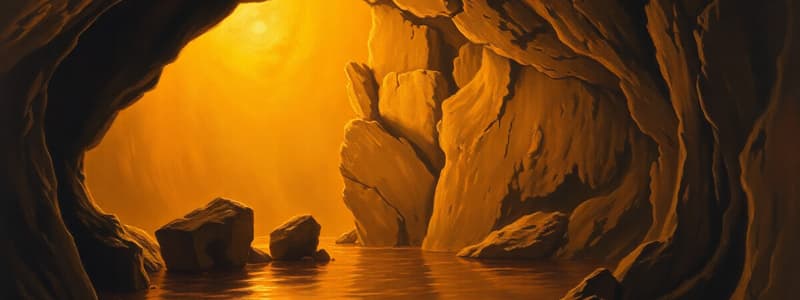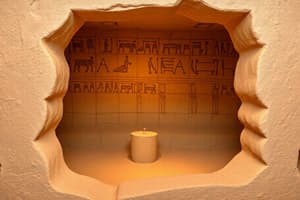Podcast
Questions and Answers
Which element was NOT a typical medium used by cave artists?
Which element was NOT a typical medium used by cave artists?
- Minerals
- Ochre
- Papyrus (correct)
- Charcoal
What was the primary purpose of Egyptian art?
What was the primary purpose of Egyptian art?
- To promote realistic portraiture
- To honor gods and pharaohs, and focus on the afterlife (correct)
- To depict scenes of daily life
- To focus on aesthetics and beauty
What artistic technique is exemplified by the Karnak Temple's colossal statues, where the size of figures denotes their importance?
What artistic technique is exemplified by the Karnak Temple's colossal statues, where the size of figures denotes their importance?
- Abstract representation
- Symbolism
- Frontal pose
- Hieratic scale (correct)
Which of the following best describes the defining characteristic of Greek sculpture?
Which of the following best describes the defining characteristic of Greek sculpture?
What innovation in Roman art allowed for the construction of larger structures?
What innovation in Roman art allowed for the construction of larger structures?
How did Roman art differ from Greek art in its focus?
How did Roman art differ from Greek art in its focus?
What was the primary purpose of Medieval art?
What was the primary purpose of Medieval art?
Which of the following is a characteristic of Medieval art?
Which of the following is a characteristic of Medieval art?
What is the main theme of Chinese painting?
What is the main theme of Chinese painting?
Which of these elements is NOT associated with Chinese painting?
Which of these elements is NOT associated with Chinese painting?
What does the term 'Ukiyo' mean in the context of Japanese art?
What does the term 'Ukiyo' mean in the context of Japanese art?
Which printing technique is most associated with Ukiyo-e?
Which printing technique is most associated with Ukiyo-e?
In cave art, what might abstract symbols suggest about early human art?
In cave art, what might abstract symbols suggest about early human art?
How did the use of marble contribute to Greek sculpture?
How did the use of marble contribute to Greek sculpture?
What design principles did Greek artists employ to create lifelike figures?
What design principles did Greek artists employ to create lifelike figures?
How did the Romans use art to reinforce their power and status?
How did the Romans use art to reinforce their power and status?
What role did monks play in the creation of Medieval art?
What role did monks play in the creation of Medieval art?
How did Medieval art connect with daily worshipers?
How did Medieval art connect with daily worshipers?
What is one of the main purposes of Chinese painting?
What is one of the main purposes of Chinese painting?
What themes were prominent in Ukiyo-e art?
What themes were prominent in Ukiyo-e art?
Flashcards
Art Movement
Art Movement
A collective name for art sharing a common style, philosophy, and technique.
Ancient Art
Ancient Art
Art from early civilizations reflecting human expression and cultural values, including Cave, Egyptian, Greek, and Roman art.
Cave Art
Cave Art
Art dating back to around 40,000 years ago, featuring paintings of animals, human figures, and abstract symbols.
Cave Art Media
Cave Art Media
Signup and view all the flashcards
Cave Art Styles
Cave Art Styles
Signup and view all the flashcards
Cave Art Purpose
Cave Art Purpose
Signup and view all the flashcards
Egyptian Art
Egyptian Art
Signup and view all the flashcards
Egyptian Art Media
Egyptian Art Media
Signup and view all the flashcards
Hieratic Scale
Hieratic Scale
Signup and view all the flashcards
Egyptian Art Purpose
Egyptian Art Purpose
Signup and view all the flashcards
Greek Art
Greek Art
Signup and view all the flashcards
Greek Art Media
Greek Art Media
Signup and view all the flashcards
Greek Art Styles
Greek Art Styles
Signup and view all the flashcards
Greek Art Purpose
Greek Art Purpose
Signup and view all the flashcards
Roman Art
Roman Art
Signup and view all the flashcards
Roman Art Media
Roman Art Media
Signup and view all the flashcards
Roman Art Purpose
Roman Art Purpose
Signup and view all the flashcards
Medieval Art
Medieval Art
Signup and view all the flashcards
Medieval Art Media
Medieval Art Media
Signup and view all the flashcards
Chinese Painting Purpose
Chinese Painting Purpose
Signup and view all the flashcards
Study Notes
- An art movement is a collective name for art with a common style, philosophy, and technique.
- The study of art movements journey begins with ancient art and progresses to 20th-century movements.
Ancient Art
- Ancient art spans early civilizations from prehistoric times to classical antiquity.
- It embodies human expression and cultural values throughout history.
- Ancient art encompasses Cave art, Egyptian art, and Greek and Roman art.
Cave Art
- Cave art began around 40,000 years ago, marking art's origin.
- The Lascaux Cave in France contains paintings of animals, human figures, and abstract symbols.
- Early humans used art for communication and to connect with their environment.
Cave Art Characteristics
- Artists utilized natural pigments from ochre, charcoal, and minerals mixed with animal fats or water to create paint.
- These paints were applied using primitive tools like twigs or animal hair.
- Artworks are characterized by simple forms, silhouettes, and outlines.
- Dynamic animals like bison, horses, and deer are depicted, along with hand stencils and geometric patterns.
- Cave art was likely used for hunting rituals and documenting significant events.
- The artists are unknown, but their works reflect a shared cultural effort of early hunters.
Egyptian Art
- Egyptian art flourished from 3000 BCE to 30 BCE.
- The art focused on the afterlife and honoring gods and pharaohs.
Egyptian Art Characteristics
- Artists used stone, wood, metal, and papyrus. Stone was used for sculptures and monuments, wood for smaller artifacts, metal for decorative items, and papyrus for painting and writing.
- Egyptian art employed the hieratic scale, where larger figures indicated higher status.
- The Karnak Temple features colossal statues of gods and pharaohs.
- Figures are often shown in frontal poses, with heads and legs in profile.
- Symbolism played a crucial role, with colors and icons carrying specific meanings.
- Green symbolized fertility and rebirth and is seen in depictions of Osiris and the ankh representing life.
- Religious and funerary purposes were primary, with artworks for temples or tombs to aid the deceased's journey to the afterlife.
- Imhotep, a major architect in ancient Egypt, designed the Pyramid of Djoser and influenced sculpture, revered as a god of wisdom and healing.
Greek Art
- Greek art, spanning from 800 BCE to 30 BCE, influenced Western culture.
- The art emphasizes beauty, humanism, and idealized representations of the human form.
Greek Art characteristics
- Artists primarily used marble, bronze, and pottery.
- Marble enabled fine detail in sculpture, while bronze allowed for dynamic poses.
- Pottery includes the black-figure François Vase, with figures painted in black on a red clay background.
- Another Pottery type is the red-figure Panathenaic Amphora, where figures retain the clay's natural red color against a black background.
- Naturalism distinguishes Greek sculpture.
- Artists used Contrapposto to give figures a lifelike sense of movement and balance.
- Greek art celebrated human achievement, mythology, and the gods.
- Art was created for public spaces and temples, reflecting civic pride.
- Phidias is renowned for the statue of Zeus at Olympia.
- Praxiteles is known for a relatable and sensual approach, exemplified by Aphrodite of Knidos (Cnidus).
Roman Art
- Roman art, from 500 BCE to 500 CE, adapted Greek influences.
- Roman art prioritized realism and everyday life, reflecting Roman society.
Roman Art Characteristics
- Artists used marble for sculptures, frescoes for wall paintings, and mosaics for decorative flooring.
- Marble offered durability and detail, frescoes added color and depth, and mosaics had intricate designs with colored stones or glass.
- Roman art emphasized portraiture, especially busts showing likeness and character, often reflecting age and wisdom.
- Architectural innovations such as the arch and dome enabled larger structures, like the Pantheon and Roman Aqueducts.
- Roman art conveyed power, commemorated achievements, and reflected cultural values.
- Public monuments honored emperors and heroes, reinforcing their status, while art in private homes mirrored social standing.
- Augustus, the first Roman emperor, promoted idealized styles and themes of peace.
- Augustus funded structures like the Ara Pacis and the Forum of Augustus (Foro di Augusto).
Medieval Art
- Medieval art (500 to 1400 CE) was heavily influenced by the church.
- Medieval art primarily had religious themes.
Medieval Art Characteristics
- Artists used illuminated manuscripts, stained glass windows, and sculpture.
- Illuminated manuscripts featured illustrations on parchment, while stained glass windows adorned cathedrals with biblical stories.
- Sculpture conveyed religious narratives on church facades and altars.
- Medieval art is known for symbolic representations such as paintings and illuminated texts.
- Art emphasized outlines and bold colors over realistic proportions.
- Figures were stylized, prioritizing spirituality, aligning with the educational purpose of art.
- The main goal was to educate and inspire religious devotion.
- It conveyed biblical stories, fostering contemplation and spiritual connection during worship.
- Many medieval artists are anonymous because individual recognition was uncommon.
- Monks dedicated to spiritual and artistic pursuits created much of the artwork.
- The Book of Kells and the Limbourg brothers' Très Riches Heures du Duc de Berry, are illuminated manuscripts.
Asian Art
- Asian art displays a rich cultural heritage, diverse religions, and philosophies over thousands of years.
- It shows cultural identity while evolving alongside traditional practices.
- Notable forms include Chinese painting and Ukiyo-e (Japanese print).
Chinese Painting
- Rooted in ancient traditions, Chinese painting emphasizes harmony with nature and philosophical concepts.
Chinese Painting Characteristics
- Traditional works mainly use ink and brush on silk or paper.
- The ink is made from natural materials, varying the tones.
- Silk has been favored for centuries, with more recent works commonly employing rice paper.
- Two main styles include landscape and calligraphy.
- Landscape painting depicts mountains, rivers, and forests while, calligraphy complements paintings and conveys philosophical ideas.
- Chinese painting expresses spiritual and philosophical concepts.
- Artists aim to convey the essence of nature and emotions such as harmony, balance, etc
- These artworks serve as meditative objects.
- Wang Wei was a Tang dynasty artist known for works like A Solitary Temple Amid Clearing Peaks.
Ukiyo-e (Japanese Print)
- Ukiyo-e emerged in Japan during the Edo period (1603-1868).
- The term Ukiyo means "pictures of the floating world" and celebrates everyday life.
Ukiyo-e Characteristics
- Artists primarily used woodblock printing for mass production.
- They carved images into wooden blocks, applied ink, and pressed paper onto the blocks to create prints.
- Ukiyo-e is known for colors, bold lines, and perspective.
- Bokashi to create color gradients and depth was employed.
- Capturing fleeting moments in beauty from landscapes, kabuki actors, beautiful people (bijin), and popular stories was the main purpose.
- Katsushika Hokusai for The Great Wave off Kanagawa
- Utagawa Hiroshige for the landscape series Fifty-Three Stations of the Tōkaidō,
Studying That Suits You
Use AI to generate personalized quizzes and flashcards to suit your learning preferences.




